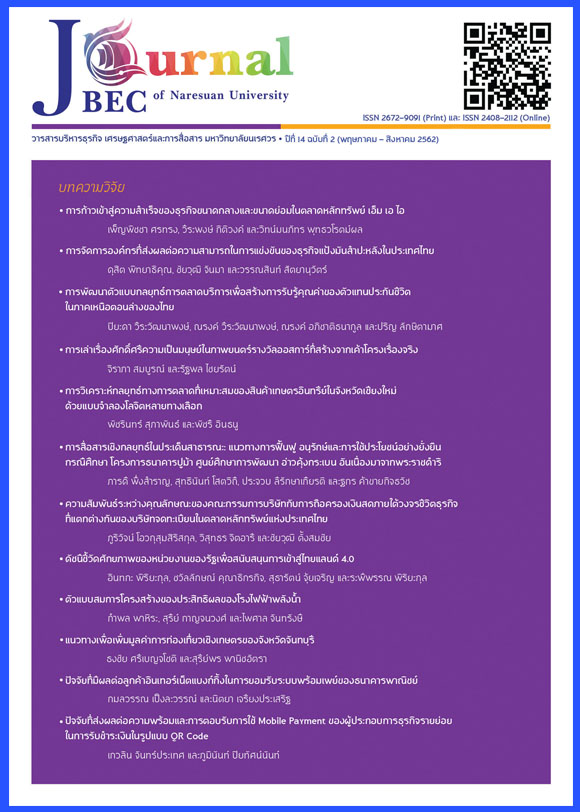การจัดการองค์กรที่ส่งผลต่อความสามารถในการแข่งขันของธุรกิจแป้งมันสำปะหลังในประเทศไทย
Main Article Content
บทคัดย่อ
การศึกษาครั้งนี้มีวัตถุประสงค์เพื่อ 1. ศึกษาสภาพปัจจุบัน 2. ความสามารถในการแข่งขันและ 3. ปัจจัยการจัดการองค์กรที่ส่งผลต่อความสามารถในการแข่งขันของธุรกิจแป้งมันสำปะหลังในประเทศไทย โดยการวิจัยเชิงปริมาณ จากกลุ่มตัวอย่าง จำนวน 78 บริษัท ซึ่งเท่ากับ ร้อยละ 83 ของประชากรทั้งหมด โดยสถิติที่ใช้ในการวิเคราะห์ข้อมูลคือสถิติเชิงพรรณนา และสถิติเชิงอนุมาน ได้แก่ ค่าร้อยละ ค่าเฉลี่ย ค่าเบี่ยงเบนมาตรฐาน ค่าสหสัมพันธ์ และการวิเคราะห์
การถดถอยพหุคูณ ผลการศึกษาพบว่า 1. สภาพปัจจุบันของการจัดการธุรกิจแป้งมันสำปะหลัง ในภาพรวมทุกด้าน อยู่ในระดับมาก ได้แก่ ด้านโครงสร้าง ด้านกลยุทธ์ ด้านรูปแบบการจัดการ ด้านระบบ ด้านค่านิยมร่วม ด้านทักษะ และด้านบุคลากร 2. ความสามารถในการแข่งขันของธุรกิจแป้งมันสำปะหลัง ในภาพรวมทุกด้าน อยู่ในระดับมาก ได้แก่ ด้านคุณภาพของสินค้า ด้านการเป็นผู้นำด้านต้นทุน ด้านการตอบสนองลูกค้า ด้านนวัตกรรม และด้านการสร้างความแตกต่าง และ 3. ปัจจัยการจัดการองค์กรที่ส่งผลต่อความสามารถในการแข่งขันของธุรกิจแป้งมันสำปะหลัง ได้แก่ ด้านกลยุทธ์องค์กร (β = 0.357) และด้านระบบปฏิบัติงานภายในองค์กร (β = 0.260) การเปลี่ยนแปลงของความสามารถในการแข่งขันของธุรกิจแป้งมันสำปะหลังในประเทศไทย สามารถอธิบายได้โดยใช้ปัจจัยด้านการบริหารจัดการ ซึ่งประกอบด้วยกลยุทธ์องค์กร และระบบปฏิบัติงานภายในองค์กรที่ร้อยละ 44.8 (Adj. R2 = 0.448)
Article Details
References
2. Colbert, J. C. (2010). Telework as part of a business continuity strategy: A path toward organizational resilience. Doctoral dissertation, Management, University of Maryland University College, Largo.
3. Dalf, R. L. (2006). Identification of the strategic planning process of small business in urban centers and the relationship with there performance. South-western: Thomson Corporation.
4. DeLoach, G. (2011). The genesis and evolution of dynamic organizational learning capabilities within the strategic product management process. Retrieved August 1, 2010, from https:// search.proquest.com
5. Du, S. M. (2010). Effect of digital enablement of business-to-business exchange on customer outcomes: The role of information systems quality and relationship characteristics. Retrieved August 1, 2010, from https://scholarworks.gsu.edu
6. Hackett, M. W. (2012). IT project portfolio management in telecommunications organizations: Strategic decision making in turbulence. Minneapolis: Capella University.
7. Hair, J. F., Black, W. C., Babin, B. J. and Anderson, R. E. (2010). Multvariate data analysis: A global perspectivc (7th ed.). New Jersey: Pearson education Inc.
8. Jutaratatkul, J. (2013). Business situation cassava. Retrieved April 25, 20016, from https://115.31.159.2/agriculture
9. Kasorn, K. (2013). The effect of market and learning orientations on competitive capabilities of the Thai automobile industry. Master thesis, D.B.A., Dhurakij Pundit University, Bangkok.
10 . Larry, G. (2016). Managers. Retrieved August 25, 2017, from https:// hbr.org/1973/03/what-managers-think-of-participative-leadership
11. Miller, A. and Dess, G. G. (1996). Strategic management (2nd ed.). New York: McGrawHill.
12. Nunnally, J. C. (1978). Psychometric theory (2nd ed.) New York: McGraw-Hill.
13. Pattana, K. (2009). The guideline that lead to the efficiency of Ranong Provincial Administration Organization. Master thesis, M.P.A., Khonkaen University, Khonkaen.
14. Rattanaprakarn, C. (2012). The effect of firms’ competitive advantage creations on beyond sufficiency-economy consumption behavior. Master thesis, D.B.A., Dhurakij Pundit University, Bangkok.
15. Suvinijjit, K. (2015). A study of strategic management of business mass communication case study: Television channel via satellite spring news. Master thesis, D.B.A., Rattana Bundit University, Bangkok.
16. Thaitapiocastarch. (2016). Cassava flour industry. Retrieved April 25, 2016, from https://www.thaitapiocastarch.org/th
17. Truncale, J. P. (2011). Interpersonal skills of highly successful business owners in the graphic communications industry. Retrieved November 23, 2014, from https://apps.prsa.org/Intelligence
18. Van-Assen, M., Van den Berg, G. and Pietersma, P. (2009). Key management models: The 60+ models to know. Harlow: Prentice Hall, 8(3), 118-125.
19. Westermann-Behaylo., M. K. (2010). Relationship between corporate ethical climate and stakeholder management. Business and Society, 53(5), 714-746.
20. Woo, K. and Ennew, C. T. (2005). Measuring business-to-business professional service quality and it consequence. Journal of Business Research, 58(9), 1178-1185.

